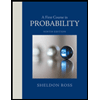
A First Course in Probability (10th Edition)
10th Edition
ISBN: 9780134753119
Author: Sheldon Ross
Publisher: PEARSON
expand_more
expand_more
format_list_bulleted
Question
Let X be a random variable distributed as Normal (5,9). Find the
- P (X ≤ 6)
- P (X > 4)
- P (|X-5| > 1)
Expert Solution
This question has been solved!
Explore an expertly crafted, step-by-step solution for a thorough understanding of key concepts.
This is a popular solution
Trending nowThis is a popular solution!
Step by stepSolved in 4 steps

Knowledge Booster
Similar questions
- A news company reported that 7% of adult Americans have a food allergy. Consider selecting 10 adult Americans at random. Define the random variable x as x = number of people in the sample of 10 that have a food allergy. Find the following probabilities. (Round your answers to three decimal places.) (a) P(x < 2) (b) P(x ≤ 2) (c) P(x ≥ 3) (d) P(1 ≤ x ≤ 2)arrow_forwardWhen circuit boards used in the manufacture compact disc players are tested, the long-run percentage of defectives is 5%. Let X the number of defective boards in a of random sample of size n= 25, so Bin(25, .05). a. Determine P(X 5). c. Determine P(1 < X < 4). d. What is the probability that none of the 25 boards is defective?arrow_forwardAn unfair coin is such that on any given toss, the probability of getting heads is 0.6 and the probability of getting tails is 0.4. The coin is tossed 8 times. Let the random variable X be the number of times heads is tossed. Find P(X=5)= Find P(X≥3)=arrow_forward
- A news company reported that 6% of adult Americans have a food allergy. Consider selecting 15 adult Americans at random. Define the random variable x as x = number of people in the sample of 15 that have a food allergy. Find the following probabilities. (Round your answers to three decimal places.) (a) P(x < 2) (b) P(x ≤ 2) (c) P(x ≥ 3) (d) P(1 ≤ x ≤ 2) You may need to use the appropriate table in the appendix to answer this question.arrow_forwardOnly handwrittenarrow_forwardA news company reported that 7% of adult Americans have a food allergy. Consider selecting 15 adult Americans at random. Define the random variable x as x = number of people in the sample of 15 that have a food allergy. Find the following probabilities. (Round your answers to three decimal places.) (a) P(x < 2) (b) P(x ≤ 2) (c) P(x ≥ 3)arrow_forward
- Let X be a normal random variable with = 9 and o 1.85 and Y be a normal random variable with u = 3 and o 0.45. Assume X and Y are independent. Find the following probabilities: (a) P(X 8, Y 3.75) (d) P(X < 12, 2.1 ≤Y ≤ 3.8)arrow_forwardFor the probability distribution of a discrete random variables, the sum of the probabilities of all possible values of x is alwaysarrow_forward
arrow_back_ios
arrow_forward_ios
Recommended textbooks for you
 A First Course in Probability (10th Edition)ProbabilityISBN:9780134753119Author:Sheldon RossPublisher:PEARSON
A First Course in Probability (10th Edition)ProbabilityISBN:9780134753119Author:Sheldon RossPublisher:PEARSON

A First Course in Probability (10th Edition)
Probability
ISBN:9780134753119
Author:Sheldon Ross
Publisher:PEARSON
